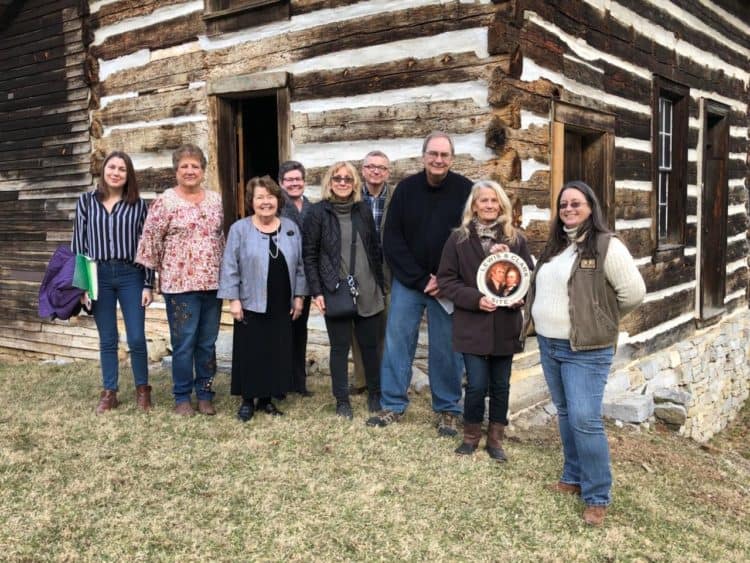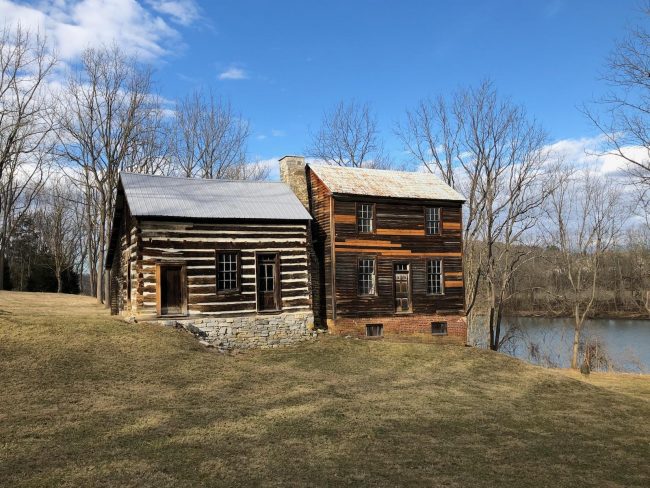Ingles Ferry added to Lewis & Clark Eastern Legacy Trail

It’s been nearly 50 years since the Ingles Ferry in Pulaski County was first added to the Virginia Landmarks Registry and months later to the U.S. National Register of Historic Places.
This past weekend Ingles Ferry added a new designation – becoming a site along Virginia’s Great Valley Lewis & Clark Eastern Legacy Trail.
April Martin, Program Coordinator for Wilderness Road Regional Museum, said Sunday during a short ceremony that she believes it fitting that Ingles Ferry be the first official site on the trail since it is probably the oldest site.
Meriwether Lewis and William Clark were commissioned by President Thomas Jefferson to explore the lands west of the Mississippi River that comprised the Louisiana Purchase. Their 8,000-mile journey began on May 14, 1804 and ended Sept. 23, 1806.

Martin explained that the National Park Services had performed a survey of the Eastern Legacy part of Lewis’ and Clark’s journey and their return trip. The survey included sites the explorers visited before and after their expedition in Kentucky, Ohio, West Virginia and Virginia, according to the 1809 memorandum ledger of Clark.
Due to a lack of funding, the National Parks Services turned the trail project over to the states for them to complete if they desired.
“Virginia wanted to, but there was no funding,” Martin said. So, a private group, Virginia’s Great Valley Lewis & Clark Eastern Legacy Trail, was formed to complete the project.
Martin said for seven years the group has been working to get points along the trail mapped, found and visited to see if structures visited by the explorers were still standing.
“We knew this one was still standing,” Martin exclaimed.
After completing an extensive vetting process, the trail committee approved Ingles Ferry as an official site along the trail.
The Ingles Ferry history dates back to the 1750s and begins with the capture in 1755 of Mary Draper Ingles by Shawnee Indians.
After escaping her captors and making her way hundreds of miles back home, she and her husband, William began farming the area of Pulaski County along the New River where today’s Wilderness Road ends.
Ingles Ferry itself was established in 1762 to carry people across the New River. The nearby tavern, which still stands today, was built about 1771, according to Mike Barbour of Dublin. His wife, Mary Ingles Barbour owns the 325-acre historic site. Mary Draper Ingles was Mary Barbour’s great-great-great-great-great-grandmother.
Prior to Sunday’s ceremony, Barbour provided those attending with a tour of the ferry tavern.
The original structure was expanded about 1800, with a third portion built on just after the Civil War ended. At some point, Barbour said, that portion burned. Part of its foundation today lies half buried in a mound outside the tavern.
Barbour said the tavern is the oldest building in Pulaski County and was the county’s first business.
After the Civil War five members of the Ingles family lived in part of the tavern, which lies directly next to where Wilderness Road originally ran.
“My wife’s ancestors were excellent business people,” said Barbour. “It made sense to make everyone come right by here.”
Barbour said the 325-acre site of the ferry and tavern is part of what once was about 6,000 acres owned by the Ingles family – an area he said stretches from today’s New River Valley Medical Center to Dublin.
A covered bridge was built at the ferry about 1840 and was the longest single span covered bridge in Virginia.
The bridge, however, lasted less than 25 years.
Confederate forces retreating from the May 9, 1864 Battle of Cloyd’s Mountain crossed the bridge to the Radford side of New River. Hay from the farm on that side of the river was used to fill the bridge and it was set ablaze to keep the Union forces from crossing.
Barbour said attention then turned to the railroad bridge nearby and Confederate and Union forces fought over that span that whole afternoon and into the evening. Union forces eventually crossed and continued through Radford and on to Blacksburg.
The ferry itself operated from 1762 until 1941.
According to Barbour a Radford Coal Company truck was being pulled across the river when the ferry capsized and sank. He said part of the ferry can still be seen about 25 feet offshore when the water level is low.
Due to the tavern’s designation as a national and state historic landmark and its location in an historic preservation easement, any nails or pieces of wood used for repairs to the Ingles Ferry tavern are required by the Interior Department to be “in kind” – or as close to original as possible.
“We save every piece of wood that comes off the tavern,” Barbour said, adding they also buy a lot of nails to make repairs. The nails are manufactured today to look identical to the old nails used in the late 1700’s.
He pointed out some newer looking siding boards on the outside of the tavern, noting they are about 350 years old and were made from wood salvaged from Charleston Harbor. Barbour theorized the wood probably came from beams inside old tobacco barns that had probably been destroyed during the Civil War, and the remains pushed into the harbor.
“A lot of the wood was salvageable, and we bought some and had it shipped up to the Shenandoah Valley to be turned into siding. All the pieces were cut to fit exactly what came off the tavern,” he explained.
Barbour said the next step in maintaining the historic structure is to replace a brick non-weight bearing wall on the back side.
Inside the tavern are a few artifacts recovered from the original structure and the land around it, including original nails, a pipe, inkwell, ballot box and the last remaining pulley from the ferry.
“It’s a work in progress,” Barbour said of Ingles Ferry, which now has a new place in history – thanks to the Lewis & Clark Eastern Legacy Trail.
By MIKE WILLIAMS, The Patriot

